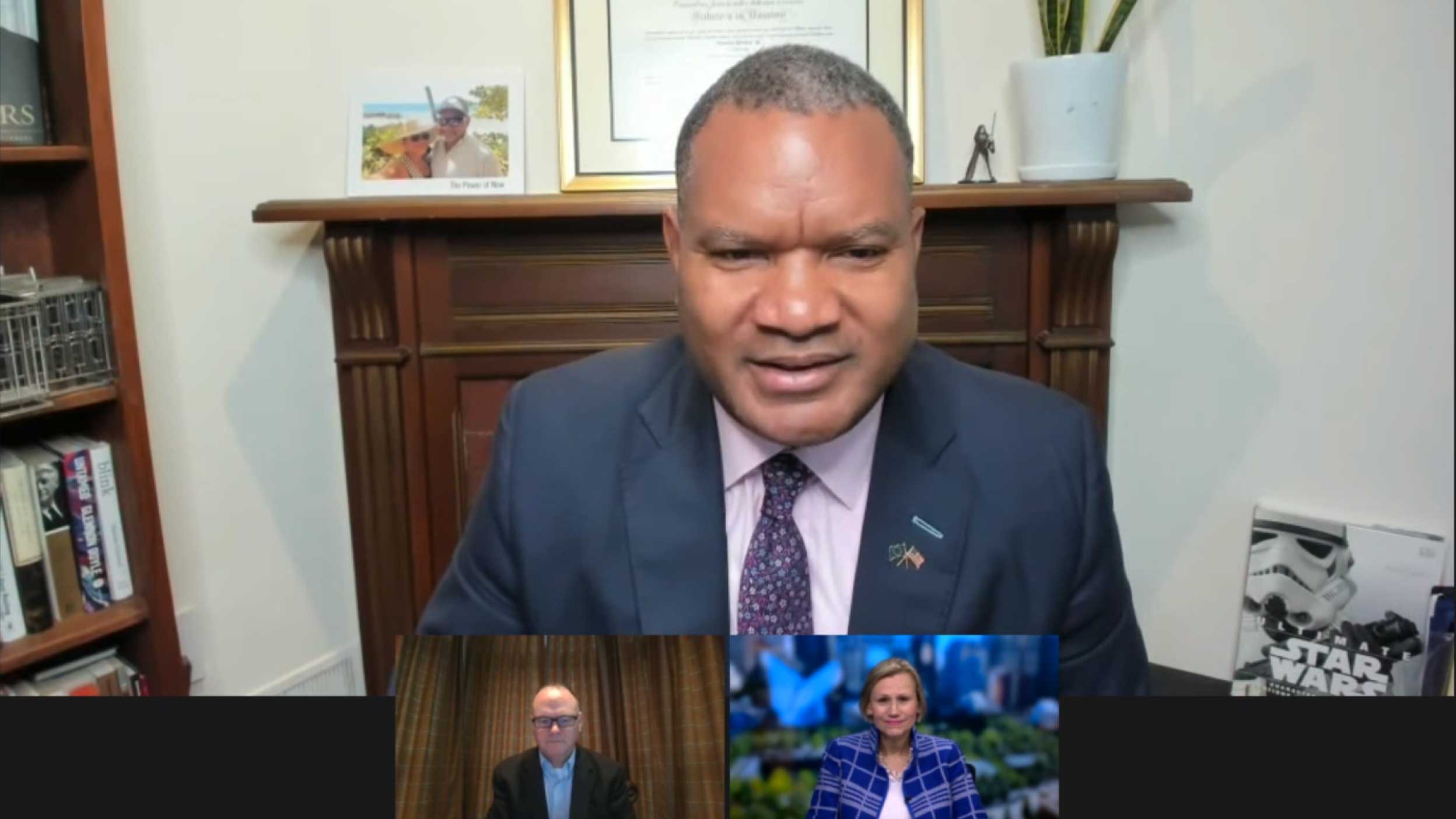
US election webinar: Trump wins. What do the results mean for investors? Our takeaways
Trump has won the race to the White House. Discover what this means for investors in the last of our three-part webinar series on the US election.

Anticipation for a Federal Reserve (Fed) rate cut has hit fever pitch, helping to fuel a big rally for stocks, especially tech, last week.
I expect the Fed to cut by 25 basis points, not 50, as a 50 basis point cut could raise alarm bells about the state of the US economy.
Fed Chair Jay Powell’s press conference could help build confidence for those worried about a US recession in the near term.
Last week was a strong one for stocks globally, led by US equities. And US equities were led by the technology sector, with the NASDAQ Composite Index rising almost 6% in one week — its best week since last November.1 Why? I certainly think part of the story is that tech has underperformed in recent weeks, and so investors were scooping up relative bargains. But there are two key drivers, in my view: anticipation of a very substantial easing cycle by the Federal Reserve (Fed), and concerns about US economic growth.
US inflation concerns have largely been put to bed, which frees up the Fed to move forward with loosening monetary policy — and that could take pressure off higher valuation assets such as tech stocks. Technology stocks are considered a “long duration” asset class, meaning they are typically more sensitive to interest rate changes because their earnings stream is farther out in the future.
Both market-based and survey-based measures of inflation expectations indicate that inflation is no longer a significant concern, which helps open the door to a significant easing cycle:
In recent years, tech has become a favored sector for investors looking for secular growth in the face of weak economic growth expectations. And we’ve seen economic growth concerns manifest in different ways, including:
Markets are clearly experiencing mixed feelings — trepidation about an economic slowdown and excitement about imminent rate cuts.
The Federal Open Market Committee (FOMC) will issue its rate decision Sept. 18. Here’s what I’ll be watching:
I expect the Fed to cut by 25 basis points, not 50. As I’ve said before, I believe a 50 basis point cut would raise alarm bells about the state of the US economy. Recall that the Fed started a brief easing cycle with a 50 basis point cut in March 2020 with the global pandemic upon us; it would be very hard to argue that the situation is so dire now and necessitates a 50 basis point cut.
In fact, the last time the Fed started a policy change, it did so with a gradual move: Even when the Fed was admittedly behind the curve in raising rates to fight inflation in March 2022, it did not start with a 50 basis point hike. It started with a 25 basis point move and quickly graduated to larger hikes. Having said that, assuming the Fed cuts by only 25 basis points this week, it will be interesting to see how many FOMC participants voted for 50 basis points. A relatively high number points to a more aggressive easing path going forward.
Comparing this announcement to the last one will shine a light on minor tweaks in language. In particular, I would be interested to see how the economy is characterized in this announcement versus the last one.
For example, in the July FOMC announcement in its assessment of the economy, the Fed characterized GDP growth as “solid,” but the FOMC acknowledged that job gains have “moderated” and noted that the unemployment rate has “moved up.”5 I would anticipate similar language this time around; more negative language could raise a red flag.
However, the language is less important this time around because we will be getting projections for both unemployment and gross domestic product (GDP) growth from FOMC members in the Summary of Economic Projections.
The FOMC Summary of Economic Projections (the SEP) contains the dot plot and several other charts of projections:
In summary, the path has been cleared for a Fed rate cut this week and arguably marks a new phase in the global easing cycle. But we should not assume it will be smooth sailing for risk assets from here. There is still significant uncertainty that will cause market volatility, from the potential for a US government shutdown to the US presidential election to the path of central bank easing – and of course what kind of landing we will see in different major economies. As such, I believe data points indicating the health of the economy will have a far larger impact on markets going forward and will contribute to volatility as well as style and sector rotations in the near term.
Date |
Event |
What it tells us |
|---|---|---|
Sept. 16 |
Eurozone Labor Cost Index
|
Tracks the total cost on an hourly basis of employing labor |
|
Empire State Manufacturing Index
|
Provides a monthly survey of manufacturers in New York State |
Sept. 17 |
German ZEW Economic Sentiment Index
|
Measures economic sentiment in Germany for the next six months
|
|
US Retail Sales
|
Indicates the health of the retail sector |
|
US Industrial Production
|
Indicates the health of the industrial sector |
|
Canada Consumer Price Index
|
Tracks the path of inflation |
|
US NAHB Housing Market Index
|
Indicates the health of the housing market |
|
New Zealand Westpac Consumer Sentiment
|
Measures the change in the level of consumer confidence in economic activity |
Sept. 18 |
UK Consumer Price Index
|
Tracks the path of inflation |
|
New Zealand Gross Domestic Product Growth
|
Measures a region’s economic activity |
|
UK House Price Index
|
Indicates the health of the housing market |
|
Eurozone Consumer Price Index
|
Tracks the path of inflation |
|
UK Producer Price Index
|
Measures the change in prices paid to producers of goods and services |
|
Bank of Canada Summary of Deliberations
|
Gives further insight into the central bank’s decision-making process. |
|
FOMC Monetary Policy Decision
|
Reveals the latest decision on the path of interest rates |
|
Central Bank of Brazil Monetary Policy Decision
|
Reveals the latest decision on the path of interest rates |
Sept. 19 |
Bank of England Monetary Policy Decision
|
Reveals the latest decision on the path of interest rates |
|
Norges Bank Monetary Policy Decision
|
Reveals the latest decision on the path of interest rates |
|
South African Reserve Bank Monetary Policy Decision
|
Reveals the latest decision on the path of interest rates |
|
US Existing Home Sales
|
Indicates the health of the housing market |
|
UK GfK Consumer Confidence
|
Tracks UK consumers' views of their finances and the economy now and for the next 12 months |
|
Japan Consumer Price Index
|
Tracks the path of inflation |
|
Bank of Japan Monetary Policy Decision
|
Reveals the latest decision on the path of interest rates |
Sept. 20 |
UK Retail Sales
|
Indicates the health of the retail sector |
|
Germany Producer Price Index
|
Measures the change in prices paid to producers of goods and services |
|
Canada Retail Sales
|
Indicates the health of the retail sector |
|
Canada Raw Material Price Index
|
Measures price changes for raw materials purchased for further processing by manufacturers operating in Canada |
|
Eurozone Consumer Confidence
|
Tracks consumers' views of their finances and the economy |

Trump has won the race to the White House. Discover what this means for investors in the last of our three-part webinar series on the US election.

In our monthly market roundup for October, Invesco experts provide a rundown of a negative month for global equities and an update on the fixed income markets.

Despite an eventful week in politics, monetary policy from central banks still matters more to markets and economies over the long term.


Sign up to receive the latest insights from Invesco’s global team of experts and details about on demand and upcoming online events.
1 Source: Bloomberg, as of Sept. 13, 2024
2 Source: Bloomberg as of Sept. 13, 2024
3 Source: University of Michigan Survey of Consumers (preliminary), Sept. 13, 2024
4 Source: Bloomberg, as of Sept. 13, 2024
5 Source: FOMC announcement, July 31, 2024
6 Source: Federal Reserve Board of Governors Survey of Economic Projections, Dec. 15, 2021
7 Source: Federal Reserve Bank of New York, as of Dec. 31, 2022
8 Source: Federal Reserve Board of Governors Survey of Economic Projections, June 12, 2024
The value of investments and any income will fluctuate (this may partly be the result of exchange rate fluctuations) and investors may not get back the full amount invested.
The opinions referenced above are those of the author as of 16 September 2024.
This document is marketing material and is not intended as a recommendation to invest in any particular asset class, security or strategy. Regulatory requirements that require impartiality of investment/investment strategy recommendations are therefore not applicable nor are any prohibitions to trade before publication. The information provided is for illustrative purposes only, it should not be relied upon as recommendations to buy or sell securities.
Where individuals or the business have expressed opinions, they are based on current market conditions, they may differ from those of other investment professionals, they are subject to change without notice and are not to be construed as investment advice.
Disinflation, a slowing in the rate of price inflation, describes instances when the inflation rate has reduced marginally over the short term.
Personal consumption expenditures (PCE), or the PCE Index, measures price changes in consumer goods and services. Expenditures included in the index are actual US household expenditures. Core PCE excludes food and energy prices.
The NASDAQ Composite Index is the market-capitalization-weighted index of approximately 3,000 common equities listed on the Nasdaq stock exchange.
The federal funds rate is the rate at which banks lend balances to each other overnight.
In general, stock values fluctuate, sometimes widely, in response to activities specific to the company as well as general market, economic and political conditions.
Fluctuations in the price of gold and precious metals may affect the profitability of companies in the gold and precious metals sector. Changes in the political or economic conditions of countries where companies in the gold and precious metals sector are located may have a direct effect on the price of gold and precious metals.
Many products and services offered in technology-related industries are subject to rapid obsolescence, which may lower the value of the issuers.
Tightening monetary policy includes actions by a central bank to curb inflation.
Easing refers to the lowering of interest rates and deposit ratios by central banks.
The Survey of Consumers is a monthly telephone survey conducted by the University of Michigan that provides indexes of consumer sentiment and inflation expectations.
A basis point is one-hundredth of a percentage point.
The Federal Reserve’s “dot plot” is a chart that the central bank uses to illustrate its outlook for the path of interest rates.
The Federal Open Market Committee (FOMC) is a committee of the Federal Reserve Board that meets regularly to set monetary policy, including the interest rates that are charged to banks.
Gross domestic product (GDP) is a broad indicator of a region’s economic activity, measuring the monetary value of all the finished goods and services produced in that region over a specified period of time.
Inflation is the rate at which the general price level for goods and services is increasing.
The neutral rate is the theoretical federal funds rate at which the stance of Federal Reserve monetary policy is neither accommodative nor restrictive.
A risk asset is generally described as any financial security or instrument that carries risk and is likely to fluctuate in price.
EMEA3864822